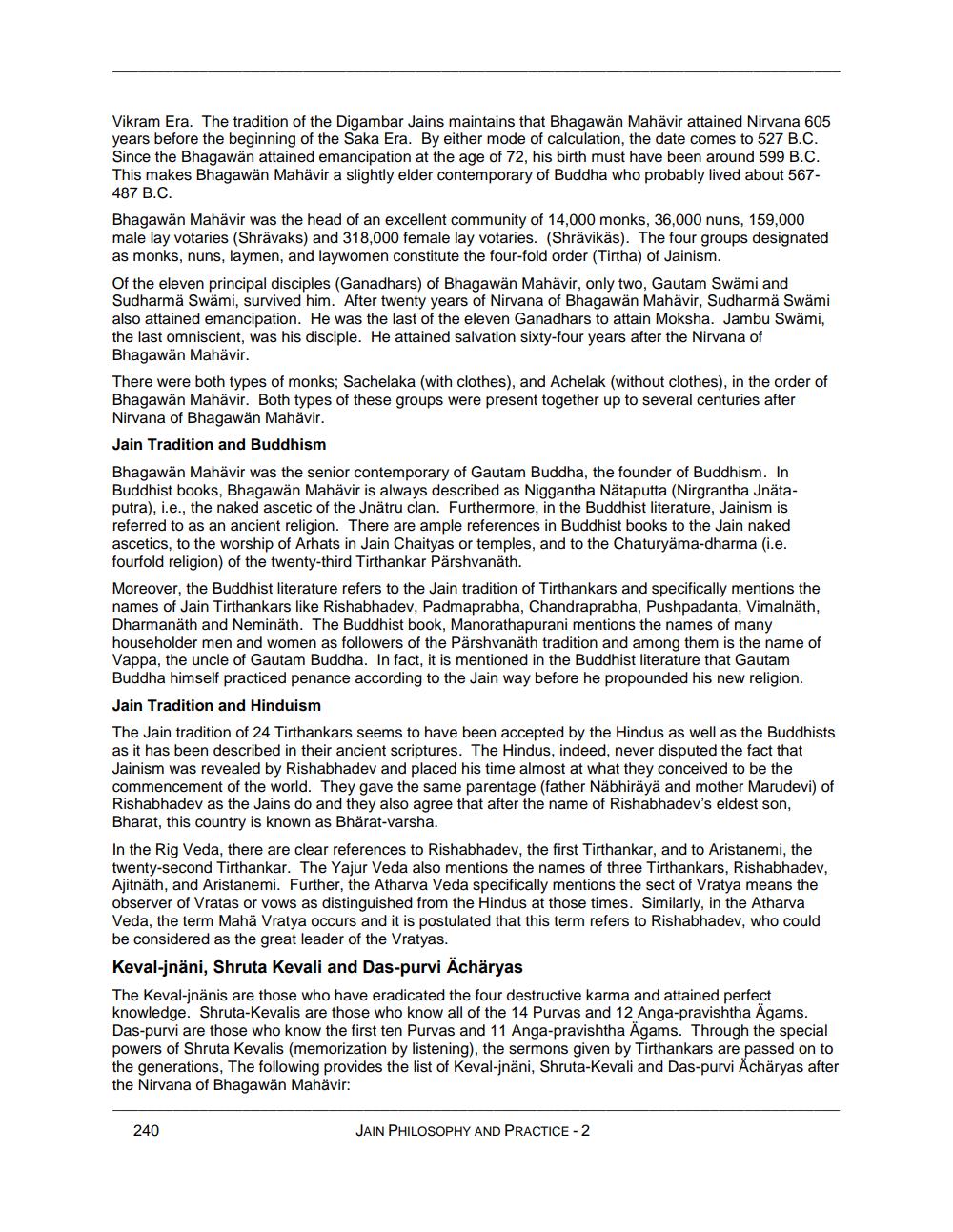________________
Vikram Era. The tradition of the Digambar Jains maintains that Bhagawan Mahävir attained Nirvana 605 years before the beginning of the Saka Era. By either mode of calculation, the date comes to 527 B.C. Since the Bhagawan attained emancipation at the age of 72, his birth must have been around 599 B.C. This makes Bhagawan Mahävir a slightly elder contemporary of Buddha who probably lived about 567487 B.C.
Bhagawan Mahävir was the head of an excellent community of 14,000 monks, 36,000 nuns, 159,000 male lay votaries (Shrävaks) and 318,000 female lay votaries. (Shrävikäs). The four groups designated as monks, nuns, laymen, and laywomen constitute the four-fold order (Tirtha) of Jainism. Of the eleven principal disciples (Ganadhars) of Bhagawan Mahävir, only two, Gautam Swami and Sudharma Swami, survived him. After twenty years of Nirvana of Bhagawan Mahävir, Sudharma Swami also attained emancipation. He was the last of the eleven Ganadhars to attain Moksha. Jambu Swami, the last omniscient, was his disciple. He attained salvation sixty-four years after the Nirvana of Bhagawan Mahävir. There were both types of monks; Sachelaka (with clothes), and Achelak (without clothes), in the order of Bhagawan Mahävir. Both types of these groups were present together up to several centuries after Nirvana of Bhagawan Mahävir. Jain Tradition and Buddhism Bhagawan Mahävir was the senior contemporary of Gautam Buddha, the founder of Buddhism. In Buddhist books, Bhagawan Mahavir is always described as Niggantha Nätaputta (Nirgrantha Jnätaputra), i.e., the naked ascetic of the Jnätru clan. Furthermore, in the Buddhist literature, Jainism is referred to as an ancient religion. There are ample references in Buddhist books to the Jain naked ascetics, to the worship of Arhats in Jain Chaityas or temples, and to the Chaturyäma-dharma (i.e. fourfold religion) of the twenty-third Tirthankar Pärshvanath. Moreover, the Buddhist literature refers to the Jain tradition of Tirthankars and specifically mentions the names of Jain Tirthankars like Rishabhadev, Padmaprabha, Chandraprabha, Pushpadanta, Vimalnäth, Dharmanath and Neminäth. The Buddhist book, Manorathapurani mentions the names of many householder men and women as followers of the Pärshvanath tradition and among them is the name of Vappa, the uncle of Gautam Buddha. In fact, it is mentioned in the Buddhist literature that Gautam Buddha himself practiced penance according to the Jain way before he propounded his new religion. Jain Tradition and Hinduism The Jain tradition of 24 Tirthankars seems to have been accepted by the Hindus as well as the Buddhists as it has been described in their ancient scriptures. The Hindus, indeed, never disputed the fact that Jainism was revealed by Rishabhadev and placed his time almost at what they conceived to be the commencement of the world. They gave the same parentage (father Näbhiräyä and mother Marudevi) of Rishabhadev as the Jains do and they also agree that after the name of Rishabhadev's eldest son, Bharat, this country is known as Bharat-varsha. In the Rig Veda, there are clear references to Rishabhadev, the first Tirthankar, and to Aristanemi, the twenty-second Tirthankar. The Yajur Veda also mentions the names of three Tirthankars, Rishabhadev, Ajitnäth, and Aristanemi. Further, the Atharva Veda specifically mentions the sect of Vratya means the observer of Vratas or vows as distinguished from the Hindus at those times. Similarly, in the Atharva Veda, the term Mahä Vratya occurs and it is postulated that this term refers to Rishabhadev, who could be considered as the great leader of the Vratyas. Keval-jnäni, Shruta kevali and Das-purvi Ächäryas The Keval-jnänis are those who have eradicated the four destructive karma and attained perfect knowledge. Shruta-Kevalis are those who know all of the 14 Purvas and 12 Anga-pravishtha Agams. Das-purvi are those who know the first ten Purvas and 11 Anga-pravishtha Agams. Through the special powers of Shruta Kevalis (memorization by listening), the sermons given by Tirthankars are passed on to the generations, The following provides the list of Keval-jnäni, Shruta-Kevali and Das-purvi Acharyas after the Nirvana of Bhagawan Mahävir:
240
JAIN PHILOSOPHY AND PRACTICE -2




